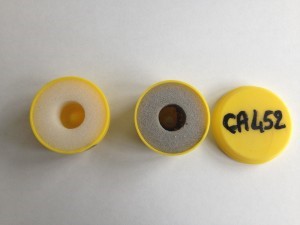What are the specific pollutions ?
Category C accreditation concerns premises with specific pollution.
It allows you to :
- measure dust concentration (inhalable and respirable)
- measure the efficiency of filtration or dust removal
- control dust collectors and ventilation monitoring systems

Inhalable and alveolar dusts: possible health effects?
Inhalable dust enters the human body through the respiratory tract. Particles larger than 5µm in diameter are predominantly deposited in the nasopharyngeal region before being removed. Alveolar dust is finer and reaches the deepest areas of the lungs (the alveoli); it generally represents « 10 to 20% of the inhalable dust fraction ».
For this reason, exposure to alveolar (and to a lesser extent inhalable) dust can cause lung overload. This acute or chronic mechanism is related to the limited capacity of the lung to clear the lungs.
What are the means of prevention and protection?
In relation to the provisions of the Labour Code, we can point out the following:
- technical means (capture, filtration, fogging);
- organisational measures (monitoring and control: installation control system, camera);
- behavioural practices and habits (regular implementation of training and information sessions on preventive measures and protection to be respected) to be deployed in the extractive industries.
How to control the risks related to dust?
For each of the Homogeneous Exposure Groups (HEG) whose risk assessment concludes that there is a « high risk » *, the employer is expected to perform at least one measurement per year.
This measure complies with the following conditions:
- carried out at a fixed or mobile station (sampling equipment carried by the worker) in each of the premises with specific pollution that are characteristic of the GEH ;
- sampling duration representative of the average daily activity in the specific pollution area(s) ;
- sampling and analysis of the samples taken :
- or by an accredited or approved Category C body;
- either by an internal or external laboratory following a protocol recognised by the profession (e.g. IMA-Europe’s Dust Monitoring Protocol); in this case, the degree of reliability of the results (uncertainty,…) is known.
Updating the risk assessment as soon as: changes in operating methods and/or conditions, changes in the characteristics of the deposit, new workstation, new dust-generating machine, etc. are made. (R. 4412-5 and R. 4121-2).
Is the use of bodies approved by the Ministry of Labour the result of regulatory provisions?
This recourse is not compulsory for all periodic checks carried out in companies; however, it will be prescribed in the case of checks carried out at the request of the labour inspectorate, or to check compliance with the limit values for the concentration of certain substances in the atmosphere.
With its experience in the field of ventilation and aeration, SUB’ROCA, is accredited to carry out all the measurements concerning premises with specific pollution and, in the event of detection of a danger for your employees, is at your disposal to accompany you in your reflection and to offer you a complete solution that will adapt to your current situation without delay.
The notion of « low risk » and « high risk » is not defined by the Labour Code.
It is considered low risk if:
- All historical measurements < VLEP ;
- The average of the historical measurements < 1/4 of the OEL (or 1/10e of the OEL for respirable silica dust) ;
- All means of prevention and protection defined in the past are properly maintained, implemented and effective;
- No history of respiratory disease or disorder.
? otherwise a « high risk » is considered for further risk assessment
The SUB’ROCA engineers are at your disposal to assist and advise you in the dimensioning of your ventilation installations. Whether your project concerns a meshed network in an underground mine or a complex digging project in another environment, our teams have the technology to calculate the air requirements and performance necessary to ensure ventilation that complies with the health and safety of personnel.
